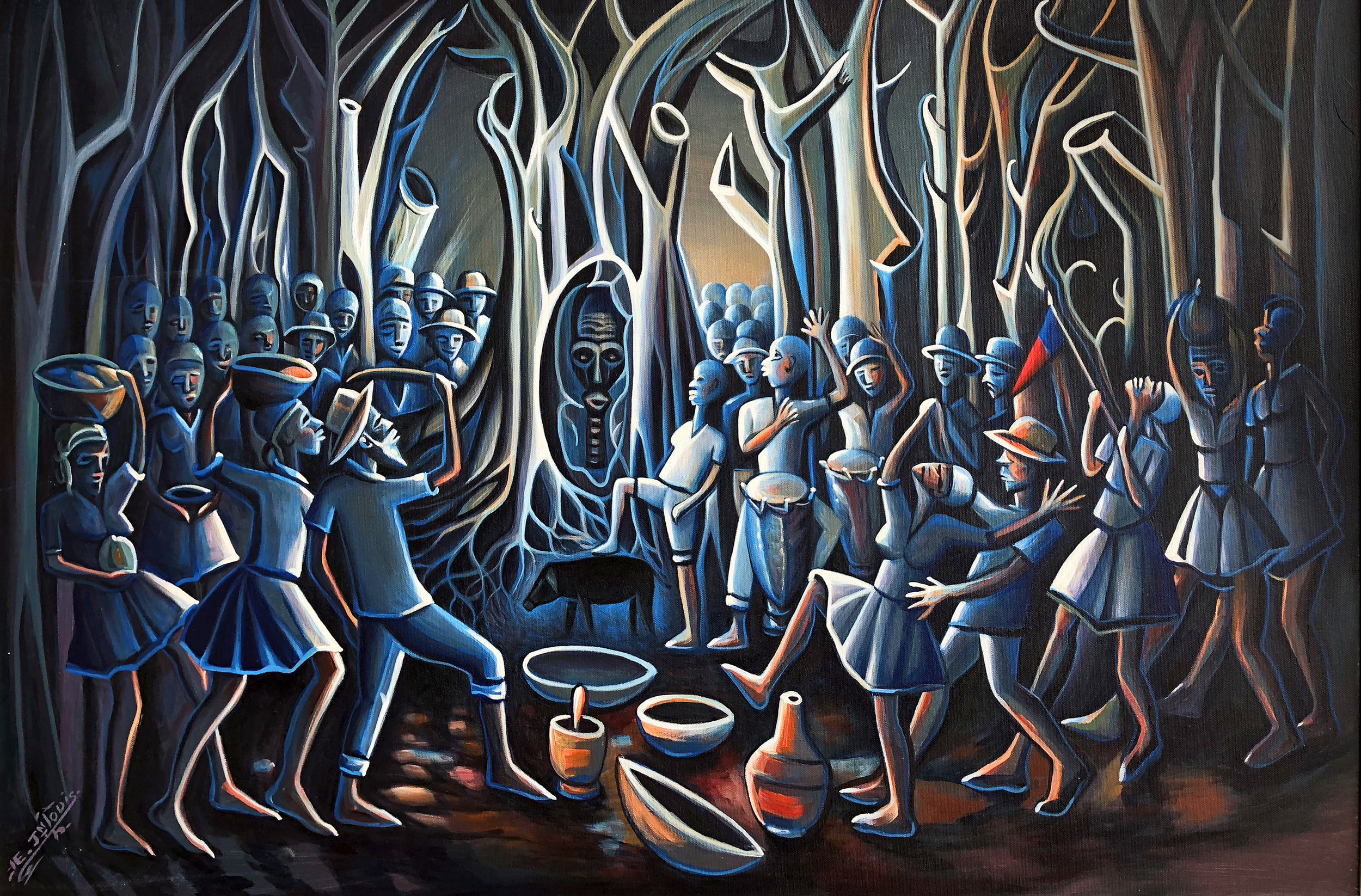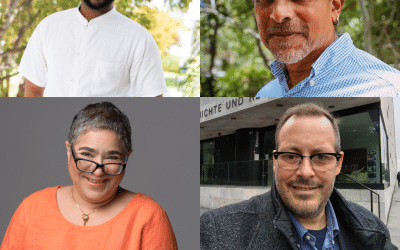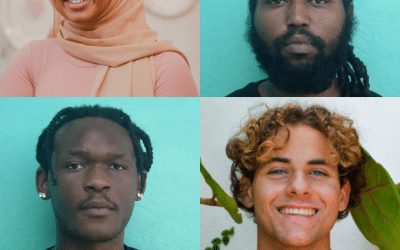
By Natalie Willis
Eric Jean-Louis (b. 1957) is an artist hailing from Haiti, well-known and much loved and it is easy to see why. His work is filled with the human and natural balance of light and dark, the duality we all struggle with and that we see in the world and in ourselves. Visually, his work packs a graphic punch with his style of shading blocks of dark and adding bright stripes and slivers of light – and they are really a stunning sight to behold. To those who find themselves cringing and shying away from the word Voodoo, as in the title of this piece “Ceremonie de Bois Cayman: The Voodoo Still Lives” (2007) by Jean-Louis, it would remiss to deny and write off this practice of art and spirituality. There is light to be found in this form of spirituality, which is so often, and erroneously, deemed ‘dark magic’. As the current exhibition, “Medium: Practices and Routes of Spirituality and Mysticism” seeks to uncover the complexities of religious and spiritual practice in the region, so does this painting lay plain the crossovers and awkwardness of our relationship as Caribbean peoples to our African heritage.
There are many iterations and names of Voodoo (Vodou, Vodun, Vodum, and so on) on this spinning ball of water and greenery we call home, but as Jean-Louis is Haitian, it might be best to focus in a little on Vodou. All these practices are rooted in West African spiritual practice, like its ‘cousin’ Obeah, and as such, we might want to reconsider just throwing the Voodoo-baby out with the Holy-Water. It is our Caribbean heritage and, more often than not, the negative depictions are what take the forefront of our minds for those unfamiliar with the truth of those practicing – we think of evil cartoon characters and conjured spirits and ill will toward others. There is, however, a much more positive and affirmative side to things, and with this ‘bois’ (forest) as the backdrop for Jean-Louis’ painting, the ties to clandestine practices in secret and nature are very much part and parcel of the history of Haitian Vodou and Voodoo in all nations who bear the weight of a history of the enslavement of Africans.
The mask-like faces give this allusion to secrecy, to an idea of illicit activities, but also perhaps to Christian-rooted carnival practices. All of this: the natural environment, the hidden quality of this religious practice in the painting, are illustrative of its beginnings. Vodou originated in Nigeria, and was developed in much of the French Empire in the 18th century (think: Haiti, and New Orleans, despite its Spanish rule at the time, having been a French colony previously) – and, as has happened with so much of our African heritage but specifically our African spiritual practices, Voodoo, Obeah, and Hoodoo were systematically outlawed, rooted out, and discouraged in displaced African slave populations in the West. However, Jean-Louis reclaims, in beautiful icy blues and darkest devil-navy, “the voodoo still lives” in 2007, and it does live on among us in small groups on this side of the Atlantic, and in much bigger groups in its birthplace on the mother-continent.
Jean-Louis’ work in the careful rendering of people looking like trees and trees looking like people around this festive sacrifice of a hog, and his affirmative titling, proclaiming that the practice “still lives” all serve to help us not forget where we come from. That, and the masked Grandmother-tree of the image, the ultimate matriarch spirit, watching over all before her. The Caribbean is a particular space in that we are both part of the African diaspora, whilst having a diaspora in our own right. This inbetweenness is what makes us so hard to pin down culturally, but is also what makes this such a rich space to be in if we allow it. The interstitial nature of being mostly Christian-serving populations, but with obvious influences in that Christianity that extend to our African ancestral spiritualities is a magic of its own. Baptists speaking in tongues and Voodoo ceremonies doing the same – they all speak to being overcome by a greater, and welcomed, power, and in believing yourself to be chosen people.
Not all Haitians practice Voodoo, but the spirit of Haitians and of Caribbeanness that we have seen, time and time again, is something to hold deference to. The strength and the quality of light that people have found in darkness and in disadvantage is a lesson that we can all learn from. For Haitians, their freedom was bloody and hard-won, and their freedom now feels much the same, but this first Black African Republic is a beacon and a beginning for Blackness and valuing Blackness the world over.
Jean-Louis elucidates and draws light to those things we ought not forget, those things that have become unfamiliar to us, and those things that should be respected and embraced alongside our colonial-Christian beliefs – we are of both European and African ancestry, so why do away with the remnants of the latter? There is a special kind of reconciliation and healing to be had in this way, by giving reverence to the past. We owe our bush medicine in The Bahamas to Obeah as Haiti does to its Vodou, and maybe we all could do with some cerasee for the spirit.
Just as Vodou uses iconography and symbols from other African religions, they also take from Taino beliefs and from Catholicism – some might think this to be something of a bastard, blasphemous mix, but it is a spiritual hybrid of what we deal with as a people. These places carry our ancestors, both good and bad (whatever that may mean), and those who didn’t live long enough to become our ancestors (the majority of Tainos, Lucayans, Arawaks and Caribs) and their energies. But they still live, the obeah still lives, the baptist still lives, the voodoo still lives, the resilience lives on in us in public and in our secret places alike.

